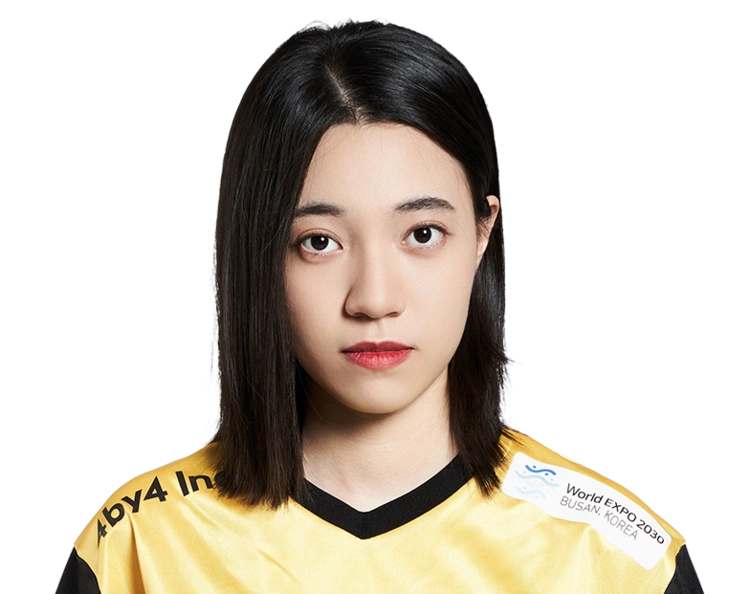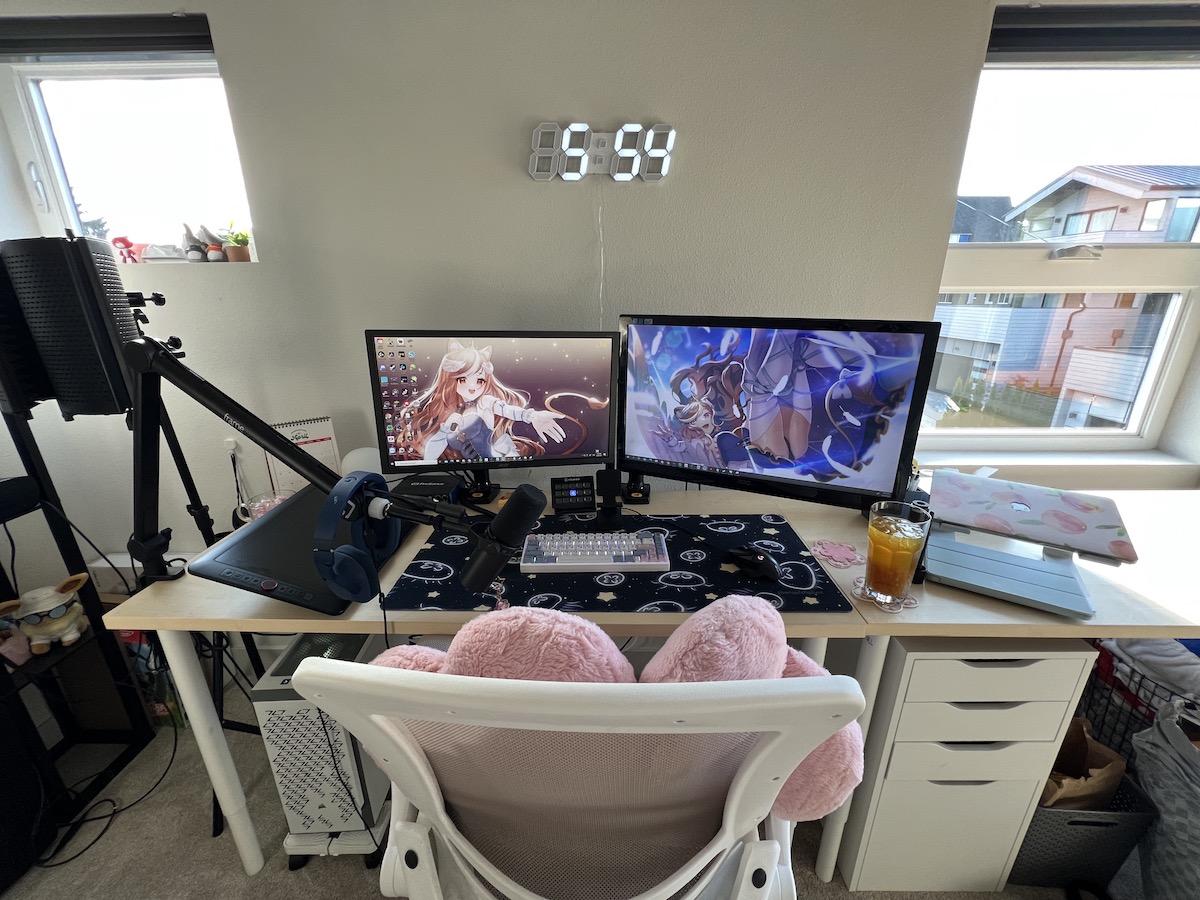The New Celebrity
Livestreamers Redefine Entertainment through Monetized Relationships
By Elise Hernke, Sangmin Kim, Accalia Rositani, Raymon Troncoso
Jeon Su-jin felt overwhelmed yet oddly calm as she looked out toward the sold-out crowd.
The stadium rumbled with a distant cacophony of murmurs. The tall duck mascot of the Lotte Giants, a professional baseball team in Busan, South Korea, led the way to the center of the field as Jeon, a small woman, walked beside him. With a baseball cap hanging around her left wrist, she shifted her gaze around the packed stadium with a slight grin.
Jeon politely bowed to the crowd in three directions while showing off her jersey with the word “DangMoo” printed on the back. She slipped on her cap. The mascot handed her a glove and a baseball.
All eyes were on Jeon when she made the first pitch, a familiar ritual for baseball fans worldwide that typically featured celebrity guests. The wild ball flew past the batter a few inches to his right, drawing a bashful smile from the woman who threw it.
Only two years before her ceremonial first pitch, a then-19-year-old Jeon was trying to fight off a man who found her family’s home address.
Jeon is the first woman in South Korea to professionally play League of Legends. It’s the videogame that drew 5.15 million viewers to the finals of the world championship last year.
In a country renowned for its esports industry, she initially gained popularity recording herself playing videogames on the livestreaming platform Twitch under the name "SoonDangMoo,” generating a large following through her enthusiastic personality and natural humor. It’s a level of internet fame that is not without its drawbacks.
Only two years before her ceremonial first pitch, a then-19-year-old Jeon was trying to fight off a man who found her family’s home address.
Even as a teen, Jeon was already wary of the consequences for being an online celebrity. She usually never left home without her parents, but on this day Jeon decided to get something to eat on her own. A few minutes after she had stepped outside, Jeon noticed a young man watching her from a distance.
This was the man who would regularly stand in front of her new house and try multiple times to use the passcode to her front door. The same man who had forced her family to move from their last house.

Jeon Su-jin recounts a terrifying stalking incident.
He grabbed her.
In the struggle that followed, Jeon’s screams drew nearby rescuers who subdued the attacker. The encounter ended with the police only giving the perpetrator a warning.
To this day, the 22-year-old livestreamer now fears the next stalker could always be watching on the other side of her screen.
Valued at over $988 million in 2022 and expected to reach a global market value of $247 billion by 2027, livestreaming online has ballooned its market share as a form of digital entertainment in the last decade. It’s content broadcasted in real time as it’s happening, shared on platforms like Twitch, YouTube and Rumble. These sites allow anyone from across the globe to tune in and watch their favorite personality play a highly anticipated video game, perform live music, vlog their pet or answer personal questions. Its live nature allows for a level of interaction between viewers and creators that’s unavailable to any other genre, and audiences love it: They tuned in worldwide for a total of 8.8 billion hours watched in the second quarter of 2023.
The number of eyeballs the industry commanded jumped sharply during the pandemic, and it still maintains a steady viewership as the world continues to reopen. A major factor is the strong appeal for youth who have grown up on the internet consuming digital content.
In the United States, the most frequent viewers of this content are 18- to 34-year olds, 15% of whom say they tune in several times a day. Twitch, the top livestreaming platform, pulls 70% of its viewers from those aged 16 to 34.
Yet, as the size and influence of the industry continues to swell, so too has the frequency of inappropriate behavior toward creators. From harassing to stalking to bullying, creators report negative and, oftentimes, damaging digital solicitations. Many streamers worry platform moderation can only go so far to handle the growing number of faceless usernames in the chatrooms and comments of their stream.
It’s a double-edged sword. Creators in livestreaming need to maintain stable communities to generate income. That means talking to and building a relationship with their viewers. It’s a more intimate connection than an actor has their moviegoers, or an author with their readership, but it can risk viewers crossing boundaries and intruding into creators’ social lives, sometimes with grave consequences.
What is the New Celebrity?
Celebrities have existed since the creation of mass media made it possible for the public to become enamored with the unique persona and interesting lives of otherwise private figures. In centuries past, these famous individuals were chronicled for the masses through media reports, often salacious, but generally never shared prolonged one-on-one interactions with their fans.
Sociologists who study the phenomenon of celebrity refer to this one-sided relationship as being “parasocial,” where followers of a popular public figure have a sense of intimacy and friendship with them: They know their families, their struggles, their thoughts on world issues and politics, maybe even formative events in their personal life, all through the disclosure of these private details by the celebrity. But unlike a real friendship, the fan is totally unknown to the celebrity.
Through livestreams, however, viewers can communicate with their favorite creators who can respond in real time, actually getting to know members of their audience and supporting the impression of a legitimate friendship. Rachel Kowert, a research psychologist and a director for the mental-wellness-in-digital-spaces nonprofit Take This, calls this dynamic a new form of parasociality: a “one-and-a-half way” relationship.
This partially reciprocal relationship can introduce new, real-world opportunities for streamers and viewers alike.
Chris Motley, a 30-year-old self-proclaimed fan of several esports streamers, said his peers have used the online streaming community to develop new skills and build out their resumes. Others used the connections they made in their niche online world to network with like-minded individuals offline, which helped them land their corporate dream jobs.
“There's just a lot of unique pathways to get into media," Motley said. “It's just getting in the right circle.”
The unique relationship between streamers and viewers has had other tangible benefits too.

From Left to Right: Sam Tighe, Jimmy Conrad, Jack Collins, Chris Motley (Speaking) at a meetup for Conrad, a popular sports streamer. Tighe and Collins later parlayed their streaming interest into careers at CBS sports.
The medium took off during the height of the COVID-19 pandemic in 2020 and 2021, as it allowed people to connect during quarantines and long periods of isolation
It wasn’t just that people were bored. Medical research shows loneliness can be highly damaging to wellbeing, and long term can lead to anxiety, depression and even physical health declines. The social interaction offered by livestreams during the pandemic reduced rates of loneliness among viewers, compared to those who consumed archived, pre-recorded content.
“I think the sense of social connectedness is just generally about being in a community,” Kowert said. “People don't watch the livestream for the content. They watch it for the creator.”
Jared Aguayo, 28, said this is exactly why he started watching streamers during his student days at the University of California, Los Angeles. Listing his favorite entertainers as mang0, and shadypenguinn, Aguayo enjoyed the skill of the players but mostly kept going back because he could identify and relate with them.
“This type of player is like ‘the best friend.’ You want to watch because he’s your homie and you vibe with him and they’re playing your favorite games,” Aguayo said.
Motley shared similar sentiments about his favorite streamers. “Last night, I was watching [Dubdot] just commenting on people playing a different video game, but he's not even good at it, it was just listening to them talk and seeing him, he's just a cool dude.”
The perspective isn’t limited to fans. Many streamers also find friends through their platform, drawing people who have common interests whether it be a game or life experience. Jeon says she thinks of her viewers not only as precious fans, but also “internet friends” who never meet.
“As a streamer, I talk and communicate with my viewers and we discuss things about me and their experiences, so it goes two ways,” she said.
Jared "Sorry_Babe" Aguayo shows off his stream setup.
Aguayo said the top streamers merge the winning duo of skills and personality. Viewers are drawn in by the gameplay but stay for the streamer’s jokes, personal stories or overall charm.
Watching his favorite streamers even inspired him to start going live when he was at UCLA, as Aguayo wanted to emulate the feelings they instilled in him as a viewer and build his own community.
Henry Jenkins, a communications professor at the University of Southern California, praises healthy social features of live online platforms and cautions against the association between online friendships and parasociality.
“If the influencer comes from the public, engages directly with the public, people don't just feel like they know them, but actually do have ongoing contact with them directly. Then to me, that's not a parasocial relationship,” Jenkins said.
Jenkins credits ASMR streamers with positively impacting his son, who is neuro atypical, during the pandemic when mental health professionals were unavailable. He says his son got a sense of belonging by interacting with creators and others in the community.
Jenkins argues that this shows fandom is more about fans’ relationships with other fans than it is with the creators. From his research, celebrities across all platforms and types of entertainment are merely vehicles for regular folks to make connections, and viewers are aware of this dynamic.
The Curious Case of VTubing
Hazumi Aileen Okazaki is a lioness knight of the Okazaki Kingdom. She is a princess and the only heir to the throne who valiantly fights against invading forces that terrorize her people.
She is also a fictional, virtual avatar and livestreamer on Twitch.
The woman behind Hazumi, granted anonymity to maintain a separation between her private life and her online persona, is part of a young subculture within the livestreaming that has rapidly grown in popularity over the last few years.
Virtual YouTubers, or VTubers, are streamers who represent themselves online with a drawn character model, often animated, in place of their real face and identity. Some will even use computer-generated graphics and motion capture to have their avatar mirror their real facial expressions and bodily movements, creating the appearance of living, breathing animated characters.
Most VTubers, like Hazumi, never reveal their true identity. Instead, they embody their VTuber model, creating new lores and personality quirks to enhance the character design. This can be anything from warriors and royalty to mythical creatures over thousands of years old.
Despite the heavy emphasis on fictional concepts, Hazumi found that she could communicate her real personality better as a VTuber than as a facecam streamer.
Hazumi began her livestreaming career showing her face on camera, but the experience of people judging her appearance in real time left her feeling overwhelmed and uncomfortable.
“People just expected you to look nice all the time,” Hazumi said. “Now, switching over to VTubing, people actually comment on my personality or my voice, and they want to stay for the actual person and not the way the person looks, which is really nice.”
On top of the equipment that streamers typically purchase, VTubers have another process to go through before they can begin streaming. After having an artist draw the character, Hazumi sent the resulting model to an animator to create its different movements. Finally, the Vtubing avatar was then carefully coded to match the movements and expressions of the woman behind Hazumi in real time. From conception to debut, 14 months of preparation and development for Hazumi's VTuber had passed.
While VTubing is now a recognized industry of its own, Hazumi recalls the days when she started as a VTuber three years ago. Back then, she felt the industry in the U.S. was more like a small, niche community of streamers and fans rather than a booming business, and Hazumi didn’t have many examples to serve as a guide for her own career. But there was a kinship among those who wanted to try it.
“The community felt a lot more like a family than anything … I definitely felt more like a family before.” Hazumi said.
Now, she says the saturated market has splintered what was once a close-knit interest group. However, this has made Vtubing more profitable and more feasible as a career.
Negative Space for Streamers
The new levels of interaction with creators made possible by livestreaming aren't always positive. There are viewers who take things to extremes and exploit their own anonymous status.
Jeon, for one, saw this manifest even before the confrontation at her home. When she first started streaming as a minor in high school, she began receiving strange emails from several unknown individuals. They ranged from inappropriate, sexual jokes to death threats. One user emailed her saying they saw her walking to school one day. Another man had asked her to grab something of his that he left behind at Pyeongtaek Station, letting her know he would wait nearby until she showed up.
Most of these did not escalate into physical confrontations, but they were enough to significantly change Jeon and her family’s way of life. They relocated multiple times to feel safe, and Jeon made an effort to never be out in public by herself.
Nonetheless, stalkers still managed to force their way into Jeon’s life.
“But then I got a little too comfortable with the people I was talking to.”
— Richard White.
Richard White, 29, had a similar experience when he signed a brand deal with the streaming service YouNow over the pandemic.
Solicited for his significant TikTok following under the account name veryrichcomedy, White accepted the deal and was told his content on the app would be put at the top of the creator list on the trending page.
After about three months, the comedian and actor regularly amassed 2,000 concurrent viewers who would watch him talk about things he’s bothered by or play the question game “Never Have I Ever.”
“But then I got a little too comfortable with the people I was talking to,” he said.
For White, one viewer in particular led to his leaving the platform. At first, they appeared to be nothing more than a big fan and benefactor, accounting for most of the cash that White would earn monthly from YouNow via donations to his channel.
Then the viewer began reaching out via direct messages on Instagram, to which White would cordially respond. This escalated until the viewer started demanding more attention and more of White’s time.
It left him in a compromising position, as the viewer continued to shelf out large sums of money that the combined contributions from the rest of White’s audience couldn’t make up for.
The scenario is a common conundrum for many creators Kowert has talked to during her work with Take This. For younger creators, it can be hard to maintain strong boundaries with their fans and large donors, especially when they demand personal attention.
“You shouldn’t feel like this is the obligation, especially when the person messaging them is like 'You owe me this. I give you money, you owe me this'" Kowert said. She thinks one way to prevent these situations is to give creators tools to navigate tricky dynamics before they emerge.
It wasn’t long after the viewer started making demands that White left YouNow. Reflecting on his time with the platform, White says the livestreaming complex encourages manipulation, with creators getting close to their viewers to make money.
“If an actor has fans, they don't see them. They'll see him at a Comic Con or something like that. Take pictures, simple as that. You can end it right there. But streaming is a live profession. It's not like you can hide behind a facade,” White said.
Even Hazumi, who was performing through a virtual avatar, would have problems with viewers overstepping. Without guidelines from the platform on managing audience engagement, Hazumi was personally responsible for instituting and enforcing hard boundaries between her and the community of fans she had developed.
“There was a point where I had to put my foot down with people … I had to really tell them, 'Hey, you guys can banter with me, and I like that,'” Hazumi said. “'But I think at some point, you have to realize that we aren't friends, we have this streamer-viewer relationship.' And I think that at some point, you need to respect that boundary."
After directly addressing the issue on stream with her audience, Hazumi says incidents of inappropriate jokes and mean comments became much less frequent, even as her following grew.
David Craig, a USC clinical professor of communication, says platforms like Twitch have come a long way as far as moderation, but there’s still a long road ahead to preventing this unwanted behavior.
He doesn’t see harassment and abuse as being inherently worse than other mediums.
“It’s just that the closer that creators can get to their online community, the greater the probability of more abusive behavior,” he said.
As the industry becomes more established, companies have taken a more serious approach to creating solutions to support the mental health of creators.
Nonprofits like Take This and Healthy Gamer have also formed in response to mental health needs in these new online spaces. They seek to address concerns that are unique to the internet generation through coaching, content, and community.
Mental health advocates who study viewer habits have seen both the positive and negative implications from the amount of time spent online.
Brooklyn-based psychotherapist Brittany Bindi says she is concerned about the obsession with streaming among many of her younger clients, aged 10-18. Her professional experience suggests a strong correlation between those who spend significantly more time online and symptoms of agoraphobia or stunted social skills.
“If there is a way for it to be monitored more,” she said. “Then it wouldn't be so negative.”
“The positive thing about it is that kids who identify with more oppressed groups, whether they're someone of color or identify with LGBTQ, it does give them a place of belonging.”
Finding Friends
After her encounter with the stalker, Jeon didn’t leave the house for six months. She harbored a new fear of people unlike anything she experienced before. She avoided meeting people and took medication for depression and social anxiety disorder.
At the same time, Jeon became the first Korean female player to reach the highest “Challenger” ranking in League of Legends, which accounts for only the top 300 players in the server. Countless interview offers poured in as the country marveled at the unprecedented talent of the young girl in a heavily male-dominated industry.
Jeon turned down all of them.
Instead, she created a new game account and started over.
With a fresh start, she played the game and met new players she hadn’t interacted with before, people that she liked. In time, they became internet friends with Jeon, actual friends who conversed together one-on-one, rather than streamer SoonDangMoo talking to hundreds of users at once in the chat. None of them were livestreamers, and Jeon became closer to them without revealing her celebrity identity.
“As I spoke with those friends, I learned that, oh, the world isn’t just filled with bad people,” Jeon said. “There are lots of people who like me even if they don’t know who I am.”




